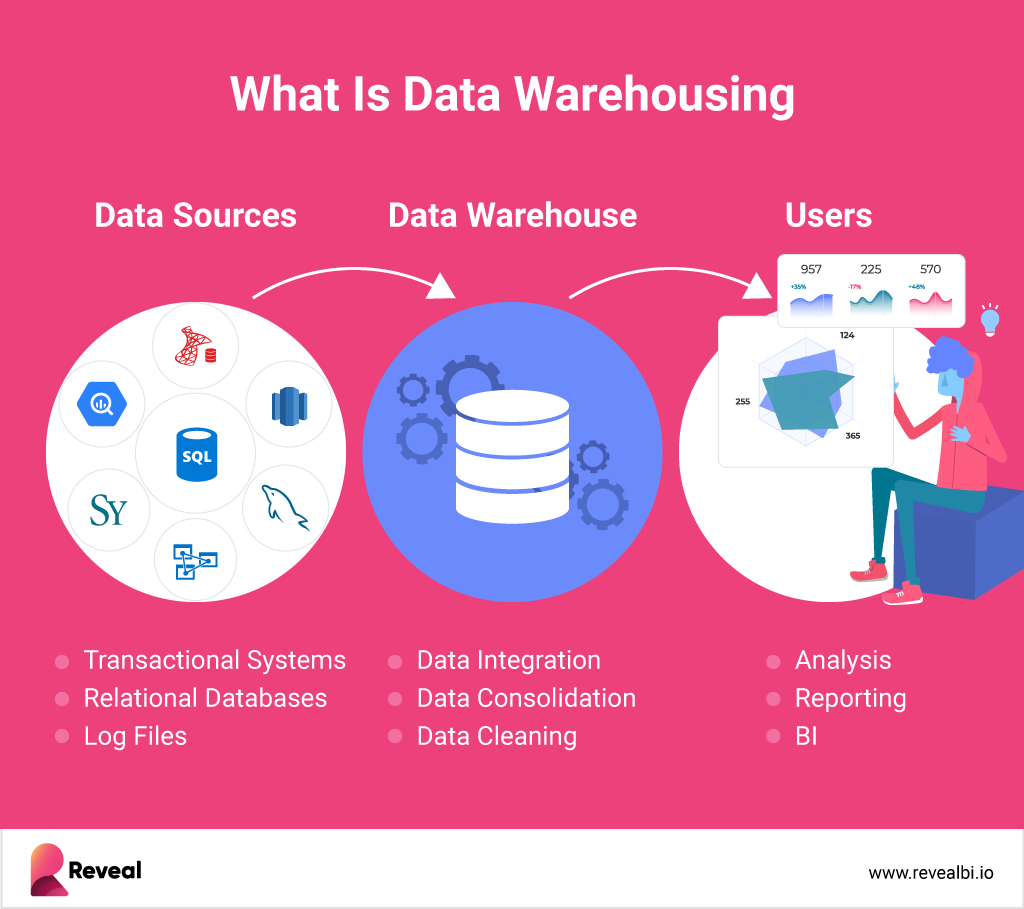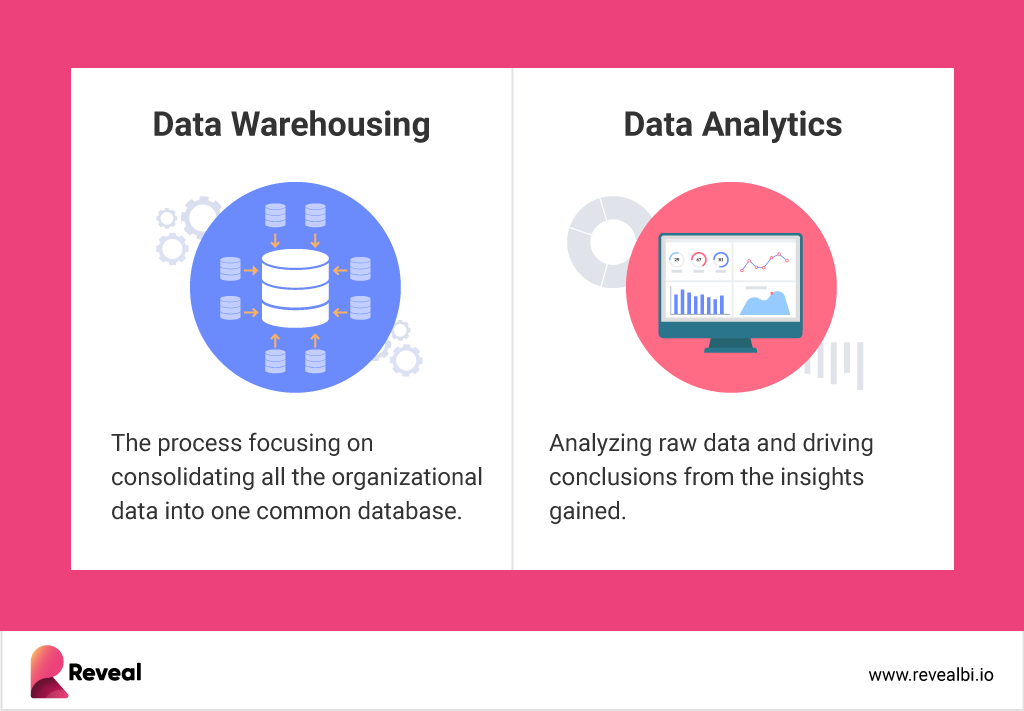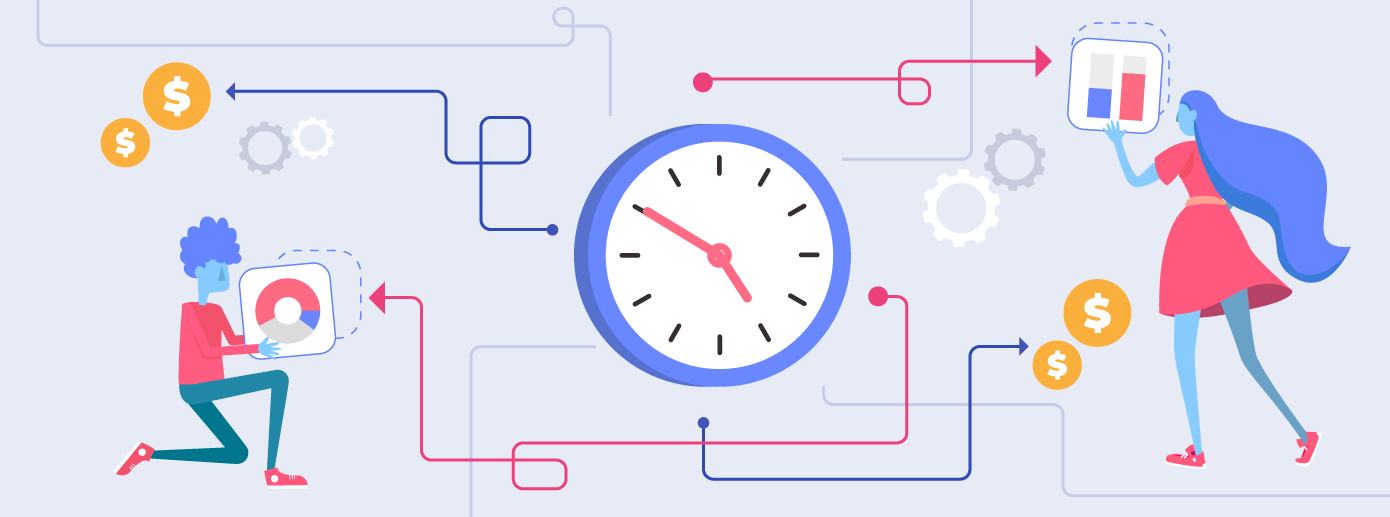
요약:
오늘날의 데이터 기반 세계에서 많은 조직에서 데이터 액세스 및 분석이 여전히 먼 목표로 남아 있다는 사실을 믿기 어렵습니다.
시장에서 살아남고자 하는 조직은 경쟁 우위를 강화하고 ROI를 극대화할 수 있도록 분석 공간의 새로운 기술과 트렌드를 따라잡아야 합니다.
내장된 분석 및 데이터 웨어하우징 도구와 프로세스는 조직이 쉽게 액세스하고 분석할 수 있도록 모든 데이터를 중앙 집중화하고 팀이나 역할에 관계없이 사용자가 실시간으로 더 스마트한 비즈니스 결정을 내릴 수 있도록 안내합니다.
이 기사에서는 데이터 웨어하우징 주제와 데이터 웨어하우징이 조직이 비즈니스 의사 결정 및 결과를 가속화하고 개선하는 데 어떻게 도움이 되는지 자세히 살펴보겠습니다.
데이터 웨어하우스란?
데이터 웨어하우스는 비즈니스 정보(데이터베이스, 데이터 레이크 또는 데이터 카탈로그와 혼동하지 말 것)의 중앙 리포지토리 역할을 하고 비즈니스 인텔리전스 (BI) 활동, 특히 데이터를 지원하도록 설계된 데이터 관리 시스템 유형입니다. 해석학. 일반적으로 데이터는 트랜잭션 시스템, 관계형 데이터베이스 및 애플리케이션 로그 파일과 같은 여러 소스에서 데이터 웨어하우스로 정기적으로 흐릅니다.
일반적으로 사용자는 분석 애플리케이션, SQL 클라이언트 또는 BI 도구를 통해 데이터 웨어하우스의 데이터에 액세스합니다.

데이터 웨어하우징이란 무엇입니까?
데이터 웨어하우징(DW)은 데이터 웨어하우스의 구축 및 사용을 지원하는 프로세스 및 기술의 조합입니다. 데이터 웨어하우징 프로세스는 오로지 쿼리 및 분석을 수행하기 위한 것이며 종종 기록 데이터를 포함하므로 사용자가 특정 기간 동안 데이터를 쉽게 분석하고 기계 학습 알고리즘 및 예측 분석 기술을 적용하여 미래를 예측할 수 있습니다. . 데이터 웨어하우징에는 데이터 통합, 데이터 통합 및 데이터 정리가 포함됩니다.
즉, 데이터 웨어하우징은 데이터를 통찰력으로 변환하고 사용자가 더 빠른 결정을 내릴 수 있도록 적시에 사용할 수 있도록 하는 프로세스입니다.
데이터 웨어하우징은 어떻게 작동합니까?
데이터 웨어하우징 프로세스는 관계형 데이터 및 기타 데이터 소스를 분석 목적으로만 다차원 스키마로 변환합니다. 이 변환 프로세스 중에 쿼리 및 검색 속도를 높이기 위해 메타데이터가 생성됩니다. 이 계층 위에는 복잡한 데이터를 ''고객'' 또는 ''제품''과 같은 이해하기 쉬운 비즈니스 언어로 구성하고 매핑하는 시맨틱 계층이 있으므로 분석가는 데이터베이스를 알 필요 없이 포괄적인 데이터 분석을 신속하게 구축할 수 있습니다. 테이블 이름. 그런 다음 마지막으로 분석가의 레이어는 시맨틱 레이어 위에 위치하여 인증된 사용자에게 데이터에 대한 액세스 권한을 부여하고 데이터를 시각화하고 해석하는 데 도움을 줍니다.
데이터 웨어하우징 및 데이터 분석
데이터 웨어하우징과 데이터 분석은 같은 것처럼 보일 수 있으며 방식이 매우 유사하고 상호 연관되어 있지만 두 개념은 서로 다른 프로세스입니다. 데이터 웨어하우징은 모든 조직 데이터를 하나의 공통 데이터베이스로 통합하는 데 중점을 둔 프로세스인 반면, 데이터 분석은 원시 데이터를 분석하고 얻은 통찰력에서 결론을 도출하는 것입니다. 데이터 분석 프로세스는 데이터 웨어하우징 프로세스가 완료된 후에만 시작할 수 있습니다.

데이터 웨어하우징이 중요한 이유는 무엇입니까?
잘 정립된 데이터 웨어하우징 프로세스는 성공적인 분석 소프트웨어의 기초입니다. 주요 기능은 대시보드 및 보고서와 같은 모든 분석 도구를 강화하여 데이터 사용자에게 더 나은 서비스를 제공하는 것입니다. 데이터 웨어하우징은 사용자에게 실행 가능한 통찰력을 제공하고 한 조직 내의 모든 사람이 마케팅 전략 및 제품 개발에서 인적 자원 및 예산 책정에 이르기까지 모든 것에 대해 올바른 결정을 내릴 수 있도록 도와줍니다.
데이터 웨어하우징의 이점
데이터 웨어하우징에는 많은 이점이 있지만 다음은 최고 중 일부입니다.
의사결정 프로세스 속도 향상– 데이터 웨어하우징은 데이터 사용자가 다양한 데이터 세트에 액세스할 수 있는 속도를 향상시켜 결과적으로 모든 사람이 실행 가능한 인사이트를 더 빠르게 도출할 수 있도록 합니다. 데이터를 목적이 있는 정보로 변환함으로써 비즈니스 사용자는 보다 정확하고 신뢰할 수 있는 분석을 수행하고 보다 유용한 보고서를 쉽게 작성할 수 있습니다.
일관성 보장– 데이터 웨어하우스는 수집된 모든 데이터에 균일한 형식을 적용하도록 프로그래밍되어 있어 조직이 수많은 소스 시스템에서 일관되고 관련성 있는 데이터를 수집할 수 있습니다. 그리고 모든 부서와 소스의 데이터가 표준화되어 있기 때문에 모든 비즈니스 사용자는 다른 모든 부서와 일치하는 결과를 생성할 수 있습니다. 표준화된 데이터는 심문 오류의 위험을 줄이고 전반적인 정확도를 향상시킵니다.
데이터 보안 강화–Forbes의 데이터 문제에 대한 설문 조사에 따르면 데이터와 관련된 합병증으로 인해 비즈니스 비용이 매년 500만 달러 이상 증가하는 것으로 나타났습니다. 데이터 웨어하우징 솔루션을 사용하고 악성 SQL 코드 및 암호화된 열을 차단하는 "슬레이브 읽기 전용" 설정과 같은 고급 보안 기술을 활용하면 모든 데이터 소스를 통합하고 보호할 수 있습니다. 이렇게 하면 데이터 위반의 위협이 크게 감소하므로 사용자는 고객의 데이터가 잘 관리되고 안전하게 유지된다는 확신을 가질 수 있습니다.
기록 인텔리전스– 기록 데이터는 일반적으로 트랜잭션 데이터베이스에 저장하거나 트랜잭션 시스템에서 보고서를 생성하는 데 사용할 수 없지만 데이터 웨어하우스는 기록 정보를 저장하므로 의사 결정자가 다양한 기간과 추세를 분석하여 미래를 예측하고 추진하기가 더 쉽습니다. 지속적인 비즈니스 개선.
시간 절약– 사용자는 동일한 플랫폼의 수많은 소스에서 중요한 비즈니스 정보에 빠르게 액세스할 수 있으므로 해당 데이터를 검색하는 데 시간을 낭비하지 않고 그 가치에 집중할 수 있습니다. 비즈니스 사용자의 시간을 절약할 수 있는 또 다른 요인은 데이터를 직접 또는 IT 지원이 거의 없이 쿼리할 수 있다는 것입니다. 이는 윈윈 상황입니다. 사용자는 IT가 보고서를 생성할 때까지 기다릴 필요가 없으며, 반면에 IT는 이 작업에서 자유롭고 가장 중요한 곳에 전문 지식을 집중할 수 있습니다.
더 높은 ROI 생성– 데이터 웨어하우징 프로세스를 성공적으로 구현한 조직은 데이터를 더 잘 이해하고 사용하는 데 도움이 되는 내장된 분석 솔루션에 아직 투자하지 않은 조직보다 더 높은 비율로 비용을 절감하면서 더 많은 수익을 창출합니다.
데이터 웨어하우징이 비즈니스 의사 결정을 가속화하는 방법은 무엇입니까?
먼저 앞서 논의한 바와 같이 효율적인 데이터 웨어하우징은 데이터 준비 및 분석을 위한 로드 시간을 가속화할 수 있습니다. 비즈니스 인텔리전스 및 분석의 세계에서 데이터 웨어하우징은 복잡한 쿼리를 제공 및 수행하고 여러 데이터 세트를 비교하여 일상적인 운영 결정에서 조직 전체의 비즈니스 확장에 이르기까지 모든 것을 알리는 데이터 스토리지의 중추 역할을 합니다.
이를 용이하게 하기 위해 임베디드 분석/BI 솔루션은 데이터 랭글링(일반적으로 추출, 변환, 로드[ETL] 기술에 의해 촉진됨), 데이터 스토리지 및 데이터 분석이라는 세 가지 중요한 활동을 포함합니다. 데이터 웨어하우징은 이 모든 것을 하나로 묶고 데이터를 통합, 요약 및 변환하여 더 쉽게 조사하고 분석할 수 있도록 하는 프로세스입니다.
그런 다음 데이터를 쿼리하여 추세, 패턴 및 인사이트를 분석하고 내장된 대시보드 및 내장된 보고서를 통해 데이터를 시각화하고 공유하는 쉬운 방법을 제공합니다.
데이터 웨어하우징과 분석이 원활하게 함께 작동하면 데이터 분석의 모든 이점을 활용하고 비즈니스 의사 결정을 가속화할 수 있습니다. 함께 결합하면 데이터 웨어하우징 및 분석 도구를 통해 데이터 사용자가 쿼리를 실행하여 즉시 데이터를 변환할 수 있는 대량의 정형 및 비정형 데이터를 동기화하고 저장할 수 있으므로 결과적으로 매번 최상의 결정을 내릴 수 있습니다.
Reveal 임베디드 분석 소개
Reveal은 팀과 고객이 임베디드 인텔리전스를 통해 데이터 통찰력을 얻고, 출시 시간을 단축하고, 앱의 사용자 경험을 혁신할 수 있도록 하는 엔드투엔드 셀프서비스 임베디드 분석 솔루션 입니다. 오늘날 가장 현대적인 아키텍처에서 임베디드를 염두에 두고 구축된 Reveal의 강력한 API는 애플리케이션에 분석을 임베딩하는 복잡성을 제거하고 Microsoft Azure SQL Data Warehouse, Google BigQuery, Amazon Redshift 등과 같은 모든 SQL 데이터베이스나 데이터웨어하우스에서 데이터를 원활하게 통합할 수 있도록 합니다.
Reveal의 임베디드 분석 플랫폼은 대화형 데이터 시각화, 화이트 라벨 기능, 머신 러닝 및 AI를 포함한 고급 분석, 드릴다운, 협업, 공유 및 드래그 앤 드롭 대시보드 생성 경험을 제공합니다. 사용자는 언제든지 모든 기기에서 영향력 있는 대시보드에 쉽게 액세스하고 만들 수 있습니다.
Reveal SDK를 다운로드 하거나 빠른 제품 데모를 예약 하여 Reveal에 대해 자세히 알아볼 수 있습니다.





